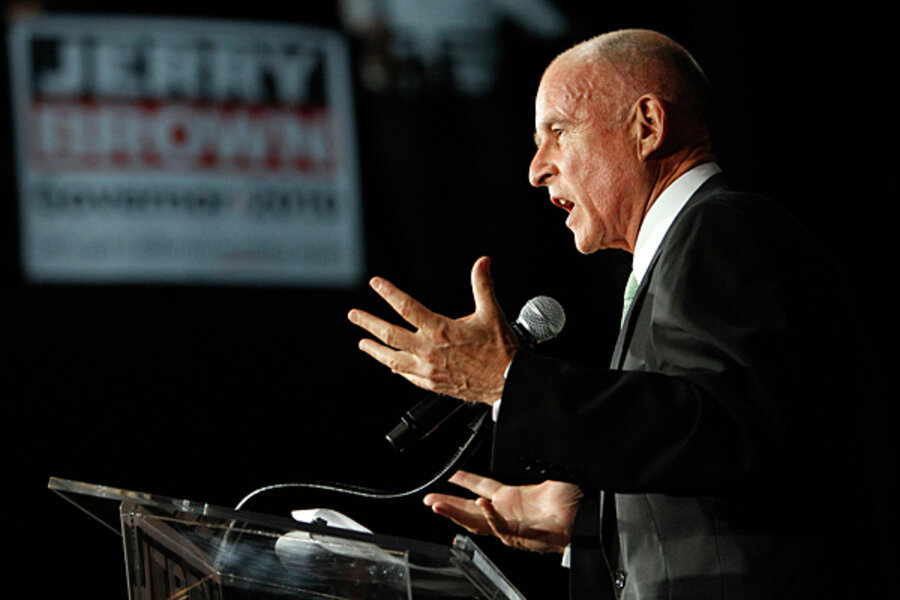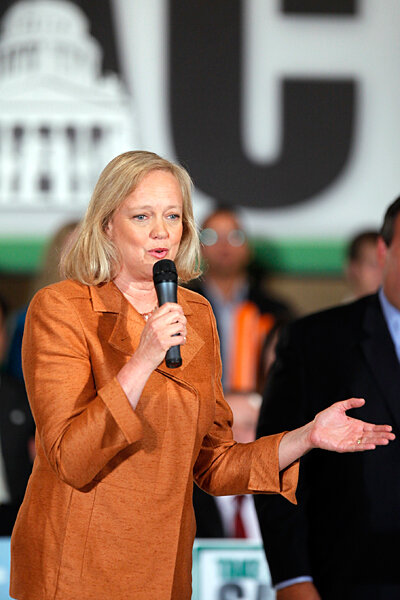Why Whitman and Brown are deadlocked in California governor's race
Loading...
| Los Angeles
The latest poll of the California gubernatorial race offers an intriguing portrait of a campaign in which neither candidate seems able to shake the other and both appear to have succeeded only in turning off voters through negative ads.
With six weeks to go before the Nov. 2 vote and five days before their first of five debates, Democratic Attorney General Jerry Brown and Republican millionaire and former eBay executive Meg Whitman are tied at 41 percent each among likely voters, according to the nonpartisan Field Poll released Wednesday.
With the debates coming, this is the beginning of a new and decisive phase in the election, and the poll holds several key surprises, says poll director Mark DiCamillo.
• Ms. Whitman has a narrow lead in Los Angeles County, which accounts for nearly 25 percent of the statewide vote. Usually, the county is key to Democratic wins – the typical path to victory for Democrats is to win liberal San Francisco and Los Angeles and then do what they can in the rest of the state, Mr. DiCamillo says. Mr. Brown has a 40 percentage point lead in San Francisco, meanwhile.
• Whitman is tied with Brown among women – a group that usually leans heavily Democratic. [Editor's note: The original version of this paragraph incorrectly called Meg Whitman the first female gubernatorial nominee in California.]
• Whitman is behind Brown among Latinos – another group that is traditionally heavily Democratic – by only 3 percentage points.
“Whitman is undercutting Brown by taking away his advantage among constituencies that are usually very clearly Democratic supporters,” says DiCamillo.
Whitman's money could be a factor. Her $119 million campaign, which recently surpassed New York Mayor Richard Bloomberg's campaign as the most expensive in US history – has spent heavily in Southern California and in the state’s Spanish-speaking media.
Despite this, Brown is holding his own because of his name recognition and California's Democratic bent, say analysts.
The Democratic advantage in party registration is 44.3 to 30.9 percent, with 20.2 percent declining to state. Moreover, Brown has the strongest name brand in California politics “and – aside from the Kennedys – the strongest name brand in any state,” says Jack Pitney, a political scientist at Claremont McKenna College.
Mr. Pitney notes that, including 2010, a member of the Brown family has been on the ballot in 14 of the 17 gubernatorial elections since 1946. Jerry's father, Pat Brown was California’s 32nd governor, serving from 1959 to 1967, and his sister, Kathleen, ran against Pete Wilson in 1994
Going negative
The debates, which begin at the University of California at Davis next Tuesday, will likely shake out a clear front runner, analysts say. Until now, both candidates have spent most of their time and money attacking each other and not been very clear about their own agendas.
“This poll reflects my own observation that neither candidate has been very specific, and that’s why we have more undecideds in this race than several weeks ago,” says Sherry Bebitch Jeffe, a political scientist at the University of Southern California in Los Angeles.
“Usually that number shrinks as the election nears," she says. "There is definitely a sense among voters that neither candidate has grabbed their hearts and minds.”
Key to the vote will be turnout, and Ms. Jeffe and others say the negative campaign has turned off voters. Both candidate’s negative numbers have risen in the latest Field Poll.
“Meg has really hammered Jerry and people don’t like that,” says Jeffe. “They feel it’s not helping her to focus so much on his weaknesses rather than articulate her own vision.”
Brown will need to overcome his penchant to be crusty and avoid the foible of appearing to beat up on a woman, say analysts. Whitman will need to avoid making a policy gaffe that can be played virally on YouTube, they add.
“They both need to give specific answers on how they are going to make voter’s lives better now without the 30-second platitudes of their TV ads,” says Barbara O’Connor, director of the Institute for Study of Politics and Media at California State University Sacramento.
Whitman to face the press
The debate format this Tuesday favors Brown’s experience, she and others say, because there is ample time for followup questions from both the candidates and the journalists on the question panel. Whitman has judiciously limited press availability so far.
“This debate will be really telling because the moderator and journalists will be gunning for her,” says Ms. O’Connor. “This will be their first opportunity to really push her, and the format lends itself to that.”
The debates are crucial, not because a lot of people will watch them, but because of the spin afterward, both in free media and pay media, says Robert Stern, president of the Center for Governmental Studies. “Neither candidate can afford to make a major blunder,” he says.
Since the polls are so tight, he says, each day for the rest of the campaign is important to the candidates. He agrees the key could be voter turnout.
“Will the Democrats overcome their apathy and actually vote?” he asks.






